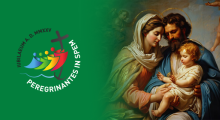Issued by the Catholic Center for Studies and Media - Jordan. Editor-in-chief Fr. Rif'at Bader - موقع أبونا abouna.org
The report of the recent archaeological excavation work carried out at the Basilica of the Holy Sepulcher in Jerusalem, by Prof. Francesca Romana Stasolla of the Department of Ancient Sciences of the Sapienza University of Rome, was published on 7 July.
"On June 27, 2023 , excavation work was completed in the area immediately in front of the Edicule , in the complex of the Holy Sepulcher in Jerusalem, as part of the restoration program for the floor of the basilica. The archaeological investigations in this area were carried out by the Department of Ancient Sciences of the University of Rome Sapienza, under the direction of Francesca Romana Stasolla The particular location of the excavation area led to the temporary closure of access to the Edicule and therefore excavation in a continuous cycle , in just seven days and nights of work.
The excavation has allowed us to discover the paleo-Christian articulation of the arrangement of the Edicule , which was accessed via two white marble steps. In front of it, there was a pavement in lithic slabs , traces of which have been found in the preparation mortar; of them it is possible to reconstruct the measurements and the trend. This pavement continued for about six meters towards the east, until it joined with a plane of large white stone blocks, well smoothed, arranged in a north-south trend. This arrangement represents the final appearance of the Rotunda at the end of the 4th century, as dated by the coin hoard found under the floor preparation in lithic slabs and which has the coins of the emperor Valens (364-378) as the latest issues.
The discovery of sections of masonry prior to the end of the 4th century confirms the presence of forms of organization of the Rotunda during the century , still to be reconstructed in their entirety.
The remains of the base of the balustrade of the sixteenth-century liturgical fence have also emerged , which remained in use until the nineteenth-century renovations.
Among the artifacts, a fragment of wall cladding appears significant, in all probability from the Edicule, from a phase prior to the 19th-century refurbishment, rich in graffiti dating back to the 18th century in various languages, among which Greek, Latin, Armenian.
The floor restoration inside the Edicule made it possible to carry out an archaeological cleaning underneath the slabs. In the Chapel of the Angel, a pavement in gray marble slabs rested directly on the rock bank, of which very few remains remain below the plinth of the current Aedicule. There are also fragments of low walls running north-south which must have formed the basis of the liturgical enclosures also mentioned by the pilgrim Egeria at the end of the fourth century; a little further inside, cuts in the rock mark the position of the small altar which supported part of the closing stone of the tomb.
Between the Chapel of the Angel and the tomb, the working of the rock and very few remains of marble wall cladding allow us to reconstruct the configuration of the opening of the room, slightly apsidal towards the chapel itself.
Inside the tomb, a previous marble flooring from the Middle Ages is visible in section , therefore the working of the rock itself , with traces of intense attendance that have made it extremely smooth. Part of the fund of a burial chamber similar to those found in the northern portion of the Rotunda has been traced and documented , filled and arranged to facilitate attendance by pilgrims since the early Christian period.















